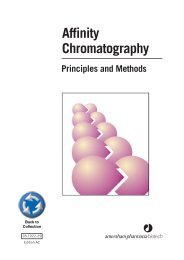Mutation of YCS4, a Budding Yeast Condensin Subunit - Molecular ...
Mutation of YCS4, a Budding Yeast Condensin Subunit - Molecular ...
Mutation of YCS4, a Budding Yeast Condensin Subunit - Molecular ...
Create successful ePaper yourself
Turn your PDF publications into a flip-book with our unique Google optimized e-Paper software.
<strong>Condensin</strong> Function and Chromosome Behavior<strong>YCS4</strong> complemented the loc7 temperature-sensitive mutation, furtherconfirming that the <strong>YCS4</strong> gene corresponds to LOC7.Generation <strong>of</strong> lacI AntibodiesLacI antibodies were generated against a GST-lacI fusion protein,pSB10, expressed and purified from bacteria. The protein was purifiedas described (Kellogg and Murray, 1995) and 0.5 mg <strong>of</strong> proteinwas injected into rabbits at BabCO (Berkeley, CA), followed by100-g boosts. The antibodies were affinity purified by first couplinga 6HIS-lacI fusion protein, pSB14, expressed and purified frombacteria, to affi-gel as described (Kellogg and Murray, 1995). Antibodieswere purified on the affinity column as described (Harlowand Lane, 1988) and subsequently dialyzed into phosphate-bufferedsaline.Immun<strong>of</strong>luorescence and MicroscopyMicroscopy was performed as described (Biggins et al., 1999).CuSO 4 was added to a final concentration <strong>of</strong> 0.25–0.5 mM to allexperiments to induce expression <strong>of</strong> the green fluorescent protein(GFP)-LacI fusion. Immun<strong>of</strong>luorescence was performed as described(Rose et al., 1990). Monoclonal 9E10 anti-myc (BabCO) andrabbit polyclonal anti-myc (Santa Cruz Biotechnology, Santa Cruz,CA) antibodies were preincubated with an untagged spheroplastedstrain two times for 10 min each at 23°C and used at 1:1000 dilution.Anti-Nop1 antibodies were kindly provided by J.P. Aris (University<strong>of</strong> Florida School <strong>of</strong> Medicine) and used at 1:5000 dilution. Antitubulinantibodies, yol 1/34, (Accurate Chemical & Scientific, Westbury,NY) were used at 1:1000 dilution. 4,6-Diamidino-2-phenylindole(DAPI; <strong>Molecular</strong> Probes, Eugene, OR) was used at 1 g/mlfinal concentration. Chromosome spreads were performed as described(Michaelis et al., 1997; Loidl et al., 1998). Monoclonal 16B12anti-hemagglutinin (HA) antibodies (BabCO) were similarly preincubatedagainst an untagged strain and used at 1:1000 dilution forMcd1–3XHAp chromosome spreads and 1:500 for Top2–3XHApand Top1–3XHAp spreads. Anti-LacI antibodies were used at adilution <strong>of</strong> 1:200. Lipsol was obtained from Lip (Shipley, England)Determining Mitotic Recombination FrequenciesThe strains to assay mitotic recombination at the rDNA and theLEU2 locus were kindly provided by R. Rothstein (Gangl<strong>of</strong>f et al.,1996; Smith and Rothstein, 1999). They were crossed to the appropriatemutant and sporulated to isolate a spore that contained boththe mutant allele and the construct to assay recombination. Becausewe are working with known and hypothesized hyperrecombinantmutants, we maintained the identified spores on URA media toensure that the starting colony for the experiment had not alreadyrecombined out the marker. Single colonies were inoculated intoYPD and allowed to grow until midlog phase. Cultures were thendiluted and plated onto YPD solid media. After growth, colonieswere counted and the plates replica-plated to URA solid media.Recombination frequencies were calculated by counting the number<strong>of</strong> colonies that failed to grow on URA and dividing that numberby the total number <strong>of</strong> colonies that grew on YPD.Fluorescence In Situ HybridizationIn situ hybridization was performed as described (Dernburg andSedat, 1998). The digoxegenin-labeled rDNA probe was a gift <strong>of</strong> A.Rudner (University <strong>of</strong> California, San Francisco). Rhodamine-conjugatedanti-digoxegenin antibodies (Roche <strong>Molecular</strong> Biochemicals,Mannheim, Germany) were used at 1:500 dilution. Z-stacks were taken spanning 4 m and the optical sectionsconverted into a stacked image with MetaMorph s<strong>of</strong>tware (UniversalImaging, West Chester, PA).RESULTSSister Chromatid Separation in ycs4-1We generated a temperature-sensitive collection <strong>of</strong> mutantsand visually screened them for defects in mitotic chromosomebehavior. Chromosomes were marked with GFP: anarray <strong>of</strong> Lac operator repeats was integrated at the TRP1locus (12 kb away from the centromere <strong>of</strong> chromosome IV)in a strain that expressed a GFP-Lac repressor (GFP-LacI)fusion (Straight et al., 1996). We isolated nine complementationgroups (loc1–9) that appeared defective in sister chromatidseparation or segregation (Biggins et al., 2001). LOC7was cloned by complementing the recessive temperaturesensitivephenotype and identified as hypothetical openreading frame YLR272C, the putative XCAPD2 homolog(Kimura et al., 1998). Recent studies have verified that thisgene is a regulatory subunit <strong>of</strong> the condensin complex and ithas been named <strong>YCS4</strong> (Freeman et al., 2000).We used GFP-marked chromosomes to analyze sisterchromatid separation in the ycs4-1 mutant (Figure 1A). Weconstructed strains that combined the mutant or wild-typecopy <strong>of</strong> the gene with the Lac operator array integrated nearthe centromere (at the TRP1 locus), on the arm, or at thetelomere <strong>of</strong> chromosome IV. Cells were arrested in G1 bytreating them with -factor at the permissive (23°C) temperatureand released into media at the nonpermissive temperature(37°C) in the absence <strong>of</strong> -factor. Figure 1A shows thatin wild-type cells, sister chromatid separation began 80 minafter release from G1 and was complete by 120 min. As inwild-type, ycs4-1 cells began sister separation at 80 min,indicating that the onset <strong>of</strong> anaphase was normal, but only afraction <strong>of</strong> the cells had managed to separate their sisters by120 min. As the position <strong>of</strong> the Lac operator array wasfurther from the centromere, the defect became more pronounced:sister separation at the TRP1 locus occurred in 77%<strong>of</strong> the cells, whereas only 49% <strong>of</strong> the cells managed toseparate the arms <strong>of</strong> sister chromatids and 29% the telomeres.The phenotype <strong>of</strong> ycs4-1 is reminiscent <strong>of</strong> that <strong>of</strong> thetop2-4 mutant, in which the inability to decatenate sisterchromatids presents a topological block to sister separation(DiNardo et al., 1984; Holm et al., 1985). In top2-4, spindleforces acting at the centromeres pull sisters apart, resultingin chromosome loss and breakage that lead to cell death(Uemura et al., 1987; Holm et al., 1989). We compared thephenotypes <strong>of</strong> the two mutants and found that althoughthey are qualitatively similar, top2-4 exhibits more severesister separation defects than ycs4-1, particularly at the armand telomere <strong>of</strong> chromosome IV (Figure 1A).To determine whether the sister chromatid separation inycs4-1 was a product <strong>of</strong> spindle forces, we analyzed chromosomeseparation in the absence <strong>of</strong> a spindle. This experimentmust be performed in spindle checkpoint mutantsbecause wild-type cells activate the checkpoint to preventcells from separating their sister chromatids in the absence<strong>of</strong> microtubules. mad and bub mutants inactivate this checkpoint(Hoyt et al., 1991; Li and Murray, 1991), allowingactivation <strong>of</strong> the anaphase-promoting complex in the absence<strong>of</strong> a spindle. Under these conditions, sister chromatidsdiffuse apart from each other without the aid <strong>of</strong> microtubules(Straight et al., 1996; Marshall et al., 1997; Straight et al.,1997). If sister separation in ycs4-1 requires microtubuledependentforces, a ycs4-1mad2 double mutant should notVol. 13, February 2002 635
















